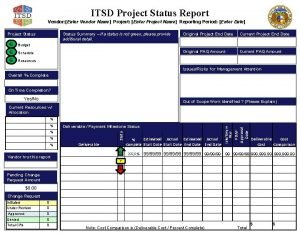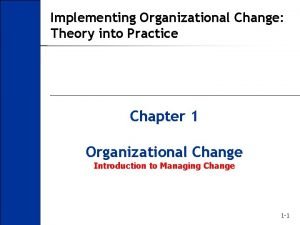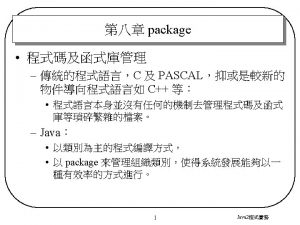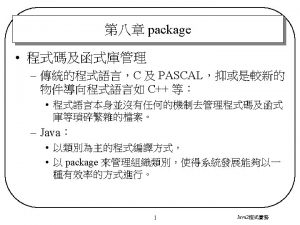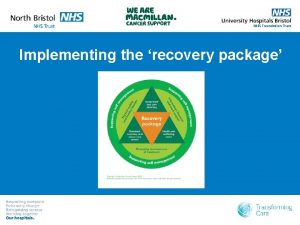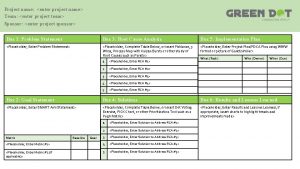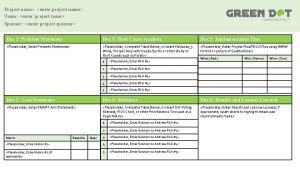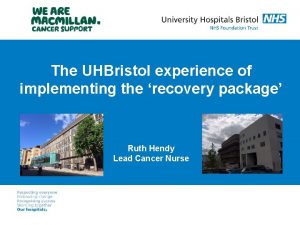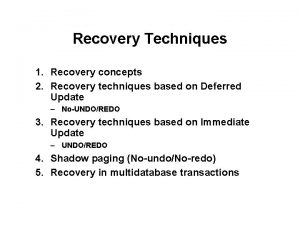Implementing the Recovery Package enter name enter role
















































- Slides: 48

Implementing the Recovery Package <enter name> <enter role> 2016

Purpose of session 1. Overview of Living with and Beyond Cancer 2. Promote wider understanding of Recovery Package 3. Explore stratification


Improvements in early detection and diagnosis More advanced treatments Move from acute to long term condition Increasing numbers of people living with and beyond cancer

50% of people with cancer in the UK now survive at least 10 years ( April 2014) Source: Macmillan Cancer Support identified median survival times based on research by the Cancer Research UK Cancer Survival Group at the London School of Hygiene and Tropical Medicine. Incidence and mortality data for the survival analysis are originally sourced from the Office for National Statistics.

The survival rates are changing Macmillan Cancer Support (2011) identified median survival times based on research by the Cancer Research UK Cancer Survival Group at the London School of Hygiene and Tropical Medicine research.

The survival rates are changing Total Prevalence - now Total Prevalence - 2030 Maddams J, Utley M, Moller H. Projections of cancer prevalence in the United Kingdom, 2010 -2040. Br J Cancer 2012; 107: 1195 -1202.

Not everyone is living well

Cancer Patient Experience Survey 2014 25% not informed about side effects before treatment 74% - Not offered a written assessment and care plan 41% - Not enough support from health and social care services after

Multi morbidity is the norm, not the exception Source: York Centre for Health Economics Research Paper 96

Cancer and other morbidities Source: Macmillan’s Routes from Diagnosis programme

The English National Cancer Survivorship Initiative Four Priorities 1. 2. 3. 4. Recovery Package Redesign follow-up Physical activity and healthy lifestyle Consequences of Treatment

Living With and Beyond Cancer

The Five Survivorship Stages Information and support from point of diagnosis Promoting recovery Sustaining recovery Managing consequences of treatment Improving Survivorship Intelligence Supporting people with active and advanced disease

The NCSI defined four priorities: 1. Recovery Package 2. Redesigning follow-up 3. Physical activity 4. Consequences of treatment



National recognition

By 2020 • Independent Cancer Taskforce A Strategy for England 2015 - 2020 • NHS Five Year Forward View • Jeremy Hunt - Secretary of State for Health has announced new measures to develop a tailored recovery package for everyone surviving cancer. • A more personalised treatment plan and better support to live well, with and beyond the disease.

The NCSI defined four priorities: 1. Recovery package 2. Redesigning follow-up 3. Physical activity 4. Consequences of treatment

• Breast 80% patients • Colorectal 50% patients • Testicular 95% patients • Project management • Clinician engagement • Patient support • Remote surveillance

The ‘How To Guide’


The NCSI defined four priorities: 1. Recovery package 2. Redesigning follow-up 3. Physical activity 4. Consequences of treatment

Physical Activity improves health and wellbeing outcomes Macmillan Cancer Support (2011). The importance of physical activity for people living with and beyond cancer.

Quick Question. . .

UK Physical Activity Guidelines by Chief Medical Officer Be active every day aiming to accumulate 150 minutes moderate intensity physical activity in bouts of 10 minutes or more. Exercise to improve muscle strength on at least two days of the week. If at risk of falling, use exercises to improve balance and co-ordination. Avoid sedentary behaviour.

50% Physical Activity Levels – people living with cancer 45% 40% 35% 30% 25% 20% 15% 10% 5% 0% Active to recommended levels Active but not to recommended levels Inactive

Do you think adults change their lifestyle behaviours after a cancer diagnosis? 46% of smokers quit 30. 1% exercise LESS

‘Exercise is safe during and after cancer treatment’. (Expert Panel at American College of Sports Medicine) https: //www. penncancer. org/pdf/pal/American_College_of_Sports_Medicine_Roundtable_on_23. pdf

Individual behaviour change The teachable moment • People are more inclined to change their lifestyle behaviour following a cancer diagnosis • They do not do so without a quality behaviour change intervention • People are more inclined to change if the issue is raised by a senior health care professional • 72% of GPs and 60% of Oncologists only talk to a few or none of their cancer patients about moving more

Visit www. macmillan. org. uk/physicalactivity

The NCSI defined four priorities: 1. Recovery package 2. Redesigning follow-up 3. Physical activity 4. Consequences of treatment


‘consequences of cancer and its treatment’ means the wide range of long-term physical and psychosocial changes that seem to be associated with cancer and its treatment however long ago the diagnosis and treatment may have been given. . This is often referred to by a range of different names, including; • side effects • late effects • toxicity • adverse effects • long-term effects • chronic effects • consequences of treatment

Body image issues Persistent hair loss Mental health problems Swallowing/speech problems Heart disease Breathing difficulties Nausea, vomiting Lymphoedema and osteoporosis Urinary or bowel incontinence Sexual difficulties

Co. T Resources Visit http: //be. macmillan. org. uk/be/s 778 -consequences-of-cancer-and-its -treatment. aspx for more

Co. T Resources for Professionals

Co. T Resources for people affected by cancer

• Early discussions about work and finance can be vital in preventing problems. • It doesn’t have to be a long discussion • You don’t have to be an expert but do need to understand the importance of work for health and wellbeing. • Macmillan has developed a range of online and offline resources to support you to have conversations and direct patients to information on work and finance and relevant services

• 82% of people think it is important to continue to work. . . • . . . but 47% have had to give up work or change roles as a result of their diagnosis • Over 60% of PLWC reported no health professional informed them about the impact cancer might have on their working life

Work is good for physical and mental health and well-being Work can help promote recovery and rehabilitation and improve quality of life. Is work good for your Health and Wellbeing. Waddell G, Burton AK (2006). Working for a healthier tomorrow Dame Carol Black, (2008).

Work and Finance Resources Visit : www. macmillan. org. uk/workandprofessional www. macmillan. org. uk/financialsupport


Living With & Beyond Cancer Resources These can be ordered from : be. macmillan. org. uk/ recoverypackage


Any Questions?

 Recovery package
Recovery package Name a line containing point a
Name a line containing point a Enter your state name
Enter your state name Enter vendor name
Enter vendor name Company name (optional)
Company name (optional) Azure worker role
Azure worker role Role making role taking beispiele
Role making role taking beispiele Statuses and their related roles determine
Statuses and their related roles determine Hrd program implementation and evaluation
Hrd program implementation and evaluation Management issues central to strategy implementation
Management issues central to strategy implementation Implementing strategies management and operations issues
Implementing strategies management and operations issues Chapter 7 strategic management
Chapter 7 strategic management The pricing tripod
The pricing tripod Implementing merchandise plans
Implementing merchandise plans Toyota brand hierarchy
Toyota brand hierarchy Designing and implementing brand marketing programs
Designing and implementing brand marketing programs Characteristics of portfolio assessment
Characteristics of portfolio assessment Crm project design and planning process
Crm project design and planning process Qsen competencies teamwork and collaboration
Qsen competencies teamwork and collaboration Challenges of implementing predictive analytics
Challenges of implementing predictive analytics Implementing organizational change spector
Implementing organizational change spector Implementing strategies marketing finance/accounting
Implementing strategies marketing finance/accounting Access rights definition
Access rights definition Checklist model project management
Checklist model project management Strategic business unit structure
Strategic business unit structure Toyota brand architecture
Toyota brand architecture Implementing nfpa 1600 national preparedness standard
Implementing nfpa 1600 national preparedness standard Implementing organizational change theory into practice
Implementing organizational change theory into practice Ubmta signatories
Ubmta signatories Nfpa 1600 business continuity programs
Nfpa 1600 business continuity programs Zpf cisco
Zpf cisco Implementing strategies management and operations issues
Implementing strategies management and operations issues Hát kết hợp bộ gõ cơ thể
Hát kết hợp bộ gõ cơ thể Ng-html
Ng-html Bổ thể
Bổ thể Tỉ lệ cơ thể trẻ em
Tỉ lệ cơ thể trẻ em Gấu đi như thế nào
Gấu đi như thế nào Chụp phim tư thế worms-breton
Chụp phim tư thế worms-breton Alleluia hat len nguoi oi
Alleluia hat len nguoi oi Các môn thể thao bắt đầu bằng tiếng bóng
Các môn thể thao bắt đầu bằng tiếng bóng Thế nào là hệ số cao nhất
Thế nào là hệ số cao nhất Các châu lục và đại dương trên thế giới
Các châu lục và đại dương trên thế giới Cong thức tính động năng
Cong thức tính động năng Trời xanh đây là của chúng ta thể thơ
Trời xanh đây là của chúng ta thể thơ Mật thư anh em như thể tay chân
Mật thư anh em như thể tay chân Phép trừ bù
Phép trừ bù độ dài liên kết
độ dài liên kết Các châu lục và đại dương trên thế giới
Các châu lục và đại dương trên thế giới Thể thơ truyền thống
Thể thơ truyền thống



